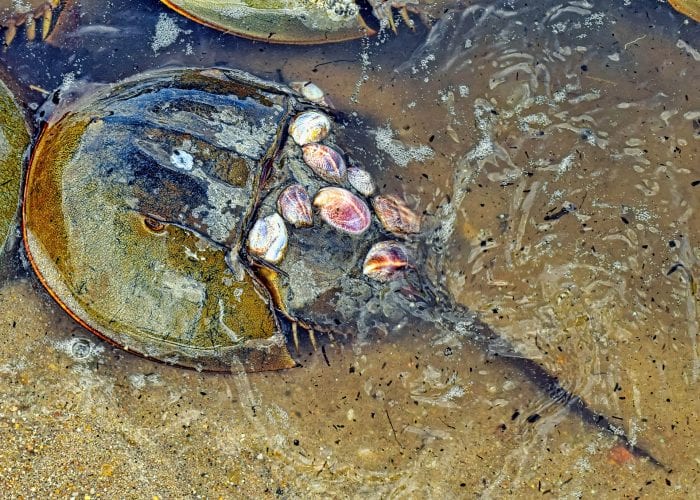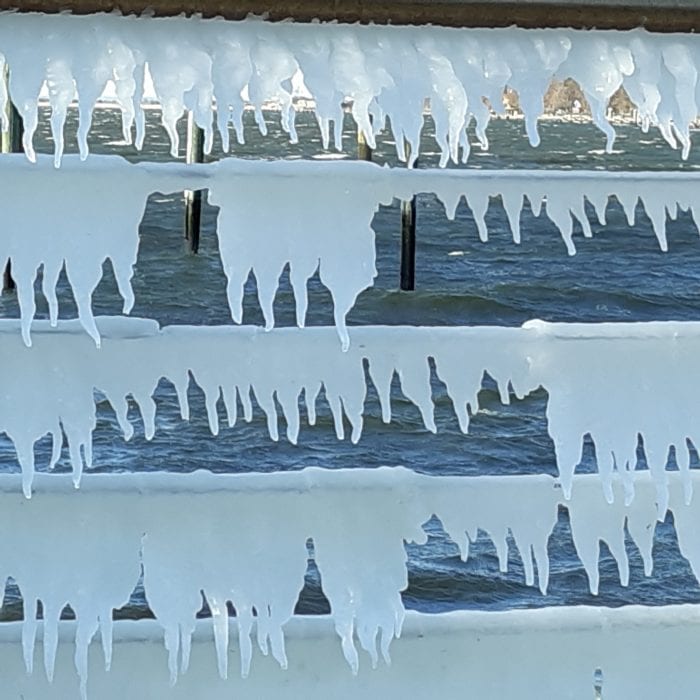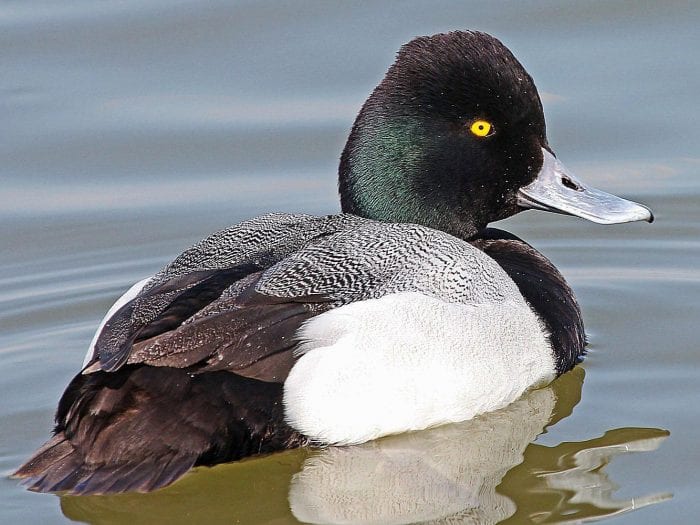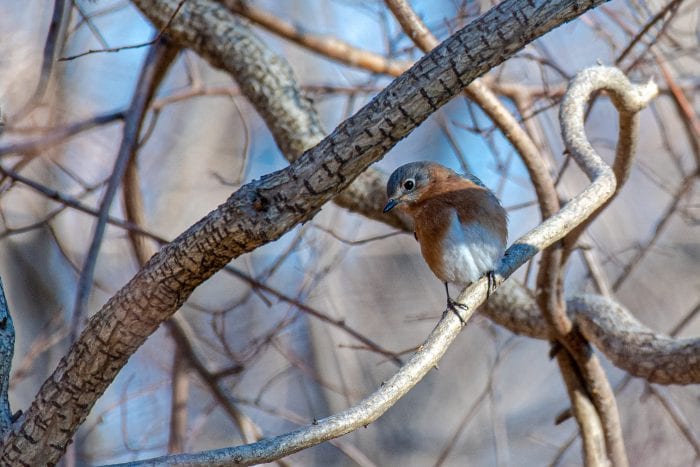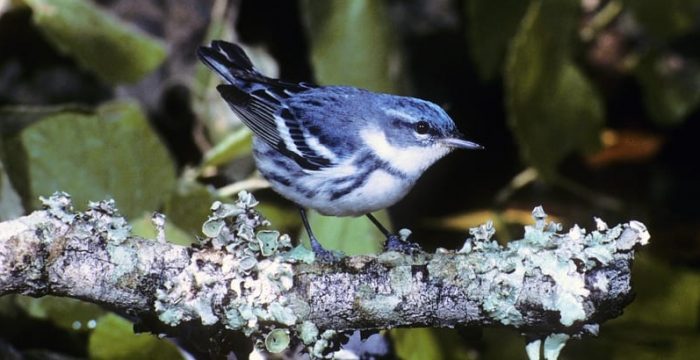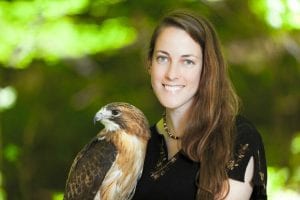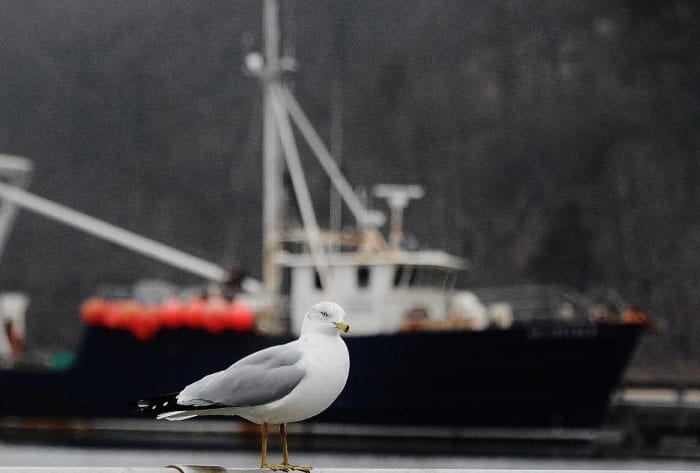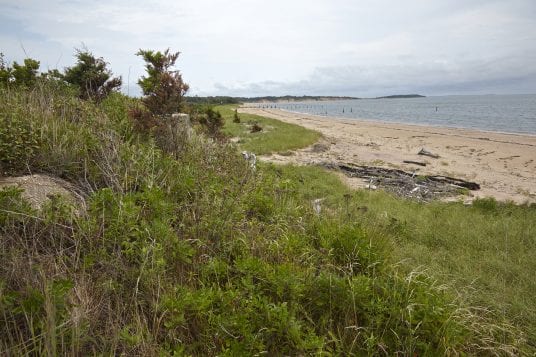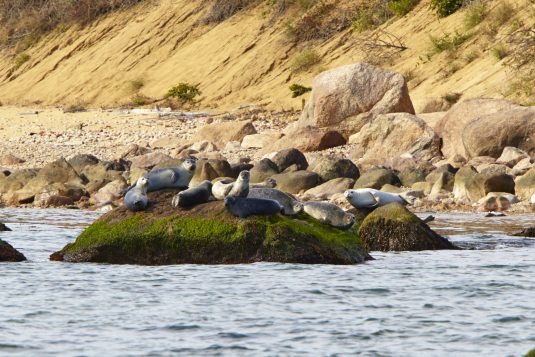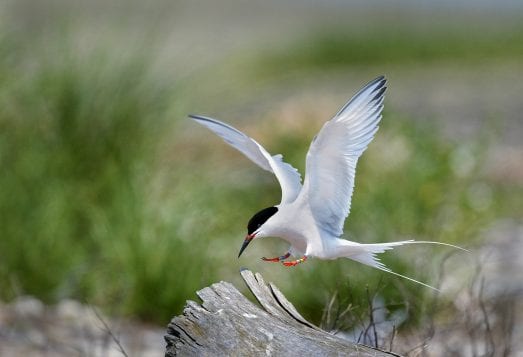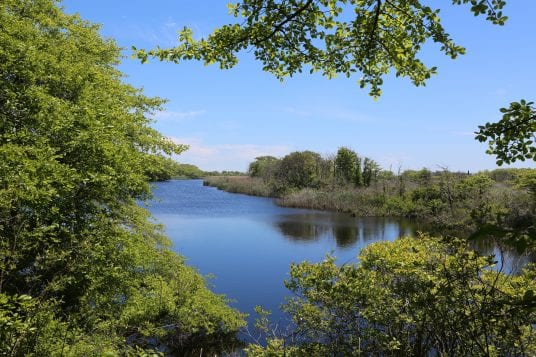By John L. Turner
Situated a mile east of Orient Point, the eastern tip of the North Fork and separated from it by Plum Gut, lies Plum Island, an 822-acre pork-chop shaped island that is owned by you and me (being the federal taxpayers that we are).
The island’s most well-known feature is the Plum Island Animal Disease Center (PIADC), situated in the northwestern corner of the property, but Plum Island is so much more. On the western edge lays the Plum Island lighthouse which was built in 1869 to warn mariners of the treacherous currents of Plum Gut. On the east there’s the brooding presence of Fort Terry, a relict of the Spanish-American War, with scattered evidence in the form of barracks, gun batteries, and the tiny tracks of a toy gauge railroad once used to move cannon shells from storage to those concrete batteries. (The cannons never fired except during drills).
And there’s the stuff that excites naturalists:
■ The largest seal haul-out site in southern New England located at the eastern tip of the island where throngs of harbor and grey seals swim along the rocky coastline or bask, like fat sausages, on the off-shore rocks that punctuate the surface of the water.
■ The more than 225 different bird species, one-quarter of all the species found in North America, that breed here (like the bank swallows that excavate burrows in the bluff face on the south side of the island), or pass through on their seasonal migratory journeys, or overwinter.
■ Dozens of rare plants, like ladies’-tresses orchids, blackjack oak, and scotch lovage that flourish in the forests, thickets, meadows, and shorelines of Plum Island.
■ A large freshwater pond in the southwestern section of the island that adds visual delight and biological diversity to the island.
■ And, of course, the ubiquitous beach plums that gave the island its name!
For the past decade a struggle has ensued to make right what many individuals, organizations of all sorts (including the more than 120-member Preserve Plum Island Coalition), and many public officials consider a significant wrong — Congress’s order to sell Plum Island to the highest bidder, forever losing it as a public space.
This ill-conceived path of auctioning the island was set in motion by a half-page paragraph buried in a several thousand- page bill to fund government agencies in 2009. Fortunately, this struggle has been won — the wrong has been righted — as language included in the recently adopted 2021 budget bill for the federal government, repeals the requirement that the General Services Administration sell the island.
Thank you to Senators Chuck Schumer and Kirsten Gillibrand of New York, Senators Christopher Murphy and Richard Blumenthal of Connecticut and members of Congress Lee Zeldin,Tom Suozzi, Rosa DeLauro and Joe Courtney!
Thanks is also due to New York State Assemblyman Steve Englebright who sponsored legislation that was signed into law creating a Marine Mammal and Sea Turtle area in the waters surrounding Plum Island.
While this victory is a vital and necessary step to ultimately protect Plum Island, it is a temporary and incomplete one since the island can still be sold to a private party through the normal federal land disposition process if no government agency at the federal, state, or local level steps up to take title to the island.
The Coalition’s next task, then, is to ensure that a federal agency such as the National Park Service (National Monument?), U.S. Fish & Wildlife Service (National Wildlife Refuge?) or the state of New York (New York State Park Preserve?) expresses a willingness to accept stewardship of this magnificent island, since they get first dibs to the island if they want it. A key enticement toward this end is the $18.9 million commitment in the budget to clean up the few contaminated spots on the island.
Why the sale in the first place? Since 1956 PIADC has been conducting top level research on highly communicable animal diseases such as foot-and-mouth disease. To this end, several years ago staff developed a vaccine for this highly contagious disease that holds great promise in controlling the disease globally.
Despite this successful research, Congress determined the facility was obsolete and should be replaced, approving the construction of a new state-of-the-art facility, known as the National Bio and Agro-Defense Facility (NBAF), to be located on the campus of Kansas State University in Manhattan, Kansas. NBAF is complete and will soon be fully operational so as a result PIADC is no longer needed; PIADC is expected to transfer all operations to Kansas and close for good in 2023.
Plum Island is a rare place — a remarkable asset that holds the promise of enriching Long Islanders’ lives —your family’s lives, if we can keep it in public ownership. The Preserve Plum Island Coalition, with the input from hundreds of Long Islanders, has painted a vision for the island … so, imagine throwing binoculars, a camera, and a packed lunch enough for you and your family into your backpack and participating in this realized vision by:
— Taking a ferry across to the island, debarking to orient your island adventure by visiting a museum interpreting the cultural and natural riches and fascinating history of the island before you wander, for countless hours, to experience the wild wonders of the island. A most worthwhile stop is the island’s eastern tip where, through a wildlife blind, you enjoy watching dozens of bobbing grey and harbor seals dotting the water amidst the many partially submerged boulders.
— Standing on the edge of the large, tree-edged pond, watching basking turtles and birds and dragonflies flitting over the surface.
-Birdwatching on the wooded trails and bluff tops to view songbirds, shorebirds, ospreys and other birds-of-prey, swallows, sea ducks and so many other species. Perhaps you’ll see a peregrine falcon zipping by during fall migration, sending flocks of shorebirds scurrying away as fast as their streamlined wings can take them.
— Strolling along the island’s eight miles of undisturbed coastline, with the beauty of eastern Long Island before you, offering distant views of Great Gull, Little Gull and Gardiner’s Islands, Montauk Point, and the Connecticut and Rhode Island coastlines.
— Lodging at the Plum Island lighthouse, converted into a Bed & Breakfast and enjoying a glass of wine as the sun sets over Plum Gut and Orient Point.
— Learning about the role Fort Terry played in protecting the United States and the port of New York as your explore the many parts of the fort — the barracks where soldiers stayed, the gun batteries that once housed the cannons angled skyward to repel a foreign attack.
— At the end of day, if you don’t stay over, taking the ferry back to the mainland of the North Fork, tired after many miles of hiking in the salt air of the East End stopping at a North Fork restaurant to share a chat among friends and family about what you’ve learned relating to this fascinating place.
This legislation has given Plum Island (based on the above perhaps we should call it Treasure Island!) a second chance and an opportunity for us to achieve this vision. But this law is only the first step. We need to take the vital second step of new ownership and management in the public interest if all of the above adventures are to become realities. We collectively need to tell those elected officials who represent us, and who can make a difference in determining the island’s fate, that we want Plum Island protected in perpetuity and the opportunity for its many wonders to become interwoven into the fabric of life on Long Island.
Go to www.preserveplumisland.org to learn more about the Coalition, receive updates, and what you can do to help.
John Turner is the spokesperson for the Preserve Plum Island Coalition.

